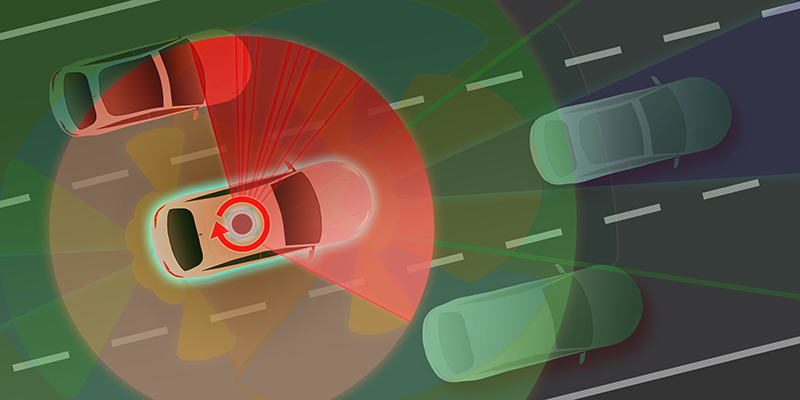You may have noticed in recent headlines: Bloomberg recently reported that Waymo (owned by Alphabet, the parent company of Google) is about to start selling its proprietary LiDAR sensors to other companies, so long as those companies don’t compete with Waymo’s taxi services.
Why is this important? Well, Bloomberg further points out that Waymo is thought to be a market leader for autonomous vehicles, a high-potential industry in which LiDAR will most likely be a key enabling technology.
Waymo is betting that mass production will help drive down production costs for LiDAR sensors. If they’re right, this could lead to a big step forward in the mass market proliferation of autonomous cars, especially in industrial applications.
But we’re getting ahead of ourselves. First, let’s examine what LiDAR really is, before unpacking how the technology could play an important role in the changing IP landscape for self-driving vehicles.

WHAT’S LIDAR?
Depending on who you ask, LiDAR stands for either “light detection and ranging” or “light + radar.”
A key challenge facing autonomous vehicles is, simply, that the car needs to “see” its surroundings. So LiDAR presents one possible solution: It uses laser light pulses to enable self-driving cars to map the surrounding environment.
LiDAR promises to provide more accurate data than other technologies, such as traditional radar. Consequently, it’s considered one of the most viable technologies for helping self-driving cars break into the mainstream.
THE OVERALL MARKET FOR LIDAR
Generally, the market reflects this optimism in LiDAR’s potential. According to Reuters, in the past three years alone, investors have poured over $1 billion into approximately 50 LiDAR startups — and the bulk of this investment ($420 million) happened in 2018.
A HIGH-RISK INVESTMENT
We don’t actually know for certain that LiDAR is the right answer to the navigation issue for autonomous vehicles. It’s not the only solution on the market either. One alternative example is Tesla’s Autopilot: Instead of LiDAR, the system relies on a combination of radar, cameras, and software.
And while investors have shown confidence in the technology, we haven’t found a cost-efficient way to mass produce it yet. According to IAM Media, LiDAR systems currently cost $50,000-$60,000 per vehicle. If the technology is going to be accepted in commercial markets, that cost needs to be reduced by 90%.
For this reason, the initial payoff for LiDAR investors is low. IHS Markit predicts that LiDAR will generate only $2.5 billion in revenue by 2025 — assuming the technology doesn’t become obsolete first.
A HIGH-REWARD GAMBLE
So why are investors still keen? In a nutshell, the technology promises to be high-risk, high-reward: at least one market research firm predicts that, in a single decade, the revenue generated by LiDAR could grow nearly twenty-fold, from $1.6 billion in 2022 to $31.5 billion by 2032.
LIDAR PATENT ACTIVITY OVER TIME
KnowMade analyzed over 6,480 LiDAR-related patents for automotive to understand how the number of LiDAR patent publications has grown over time. They’ve compiled their findings in a graph; please click the thumbnail on the right to view the full graph on EE Times’s website.
From the data plotted in the graphic, we can see that there’s been an exponential increase in LiDAR patenting activity in recent years. KnowMade itself reports that, between 2007 and 2017, LiDAR patenting activity grew at an annual compound growth rate of 21%.
TOP PATENT ASSIGNEES FOR LIDAR-RELATED PATENTS
As research from IAM Media indicates, the top five patent assignees for LiDAR-related patents are:
- Google/Waymo
- Continental Automotive
- AEye
- Valeo
- Leddartech
LEADING PIONEERS OF LIDAR TECHNOLOGY: A SNAPSHOT OF THEIR PATENT APPROACH
We know the industry hasn’t yet defined a LiDAR technological standard that’s viable for mass market production.
That said, IAM Media has identified the three most promising LiDAR systems — here’s where each stands:
- Mechanically spinning: Currently the “classic” LiDAR system.
- Solid-state: Has the potential to cost less than mechanically spinning systems. Solid-state systems have no moving parts, which makes them more efficient in terms of reliability, weight, size, power efficiency, and cost.
- Moving mirrors
IAM Media also dug deep into the patent portfolios of several major players in the LiDAR space to identify which systems they’re investing in, as well as their overall approach towards patenting. We’ve summarized those findings below.
Our key takeaway, though, is that most major players aren’t filing tons of applications — which suggests that they are focusing on quality over quantity and relying on trade secret protection to the extent possible. We know from the Uber v. Waymo saga that trade secrets in the autonomous vehicle space have been highly valued and fiercely protected within the industry.
WAYMO (GOOGLE/ALPHABET)
Waymo is an industry leader for autonomous vehicles, and so has a vested interest in finding cost-effective ways to mass produce its LiDAR technology.
But Waymo didn’t always produce its own LiDAR technology. Waymo was founded in 2009, and during its early years, Waymo licensed its LiDAR from Velodyne. Waymo only began producing LiDAR technology in-house in 2012.
Starting in 2013, Waymo began a surge in LiDAR-related patent activity across all aspects of the technology.
Since then, Waymo’s patent portfolio has steadily grown. Research from IAM Media shows that Waymo’s patent holdings have gradually increased from seven patents in 2012 to 32 patents in 2017.
The technology covered by in Waymo’s patents focus on mechanically spinning LiDAR systems. Waymo is highly committed to this approach; they apparently haven’t filed any patents depicting other LiDAR systems.
That said, IAM Media notes that Waymo has prepared for a possible industry shift towards solid-state LiDAR systems — the company also holds hardware and processing patents that would remain relevant, should that happen.
VELODYNE
Founded in 2005, Velodyne is a leading producer of LiDAR sensors. Building a robust patent portfolio didn’t use to be a top priority for Velodyne; as of 2012, the company only had one issued patent.
However, this looks to be changing. Research by IAM Media indicates that Velodyne’s patent activity has been steadily increasing between 2012 to 2017.
The technology covered by Velodyne’s patents focuses mainly on mechanically spinning systems. But Velodyne has also recently begun exploring solid-state systems: In April 2017, the company patented its first LiDAR sensor based on solid-state technology.
QUANERGY
Founded in 2012, Quanergy started out innovating with traditional, mechanically spinning LiDAR systems, but quickly pivoted. Today, the bulk of its portfolio is focused on solid-state LiDAR systems.
LUMINAR
Luminar was founded in 2012, but only exited stealth mode in 2017, making it one of the newest entrants to the LiDAR market.
According to IAM Media, “its six granted patents and three pending patent applications focus on the laser source used and on increasing the scanning speed of the entire system.”

THE IMPORTANCE OF COLLABORATION IN THE LIDAR SPACE
Many companies — from tech startups to tech giants alike — are investing in an IP-centric approach. Specifically, they’re creating IP assets with the potential to become standard-essential patents.
Autonomous vehicles are highly reliant on technology created by multiple entities. We’ve raised several examples in our blog post detailing Uber’s patent strategy, such as Uber’s need to know the specifications for a Volvo SUV in order to retrofit self-driving technology into the car.
Similarly, close collaborations between companies will be essential to unlocking LiDAR’s full potential. After all, many pure automotive firms don’t have robust LiDAR patent portfolios, which means their self-driving cars are likely reliant on partnerships with or investments in leading LiDAR innovators.
Indeed, a study by Reuters shows that the top startups operating in the LiDAR space have all received extensive financial support from general tech corporations and automotive firms.
PARTNERING WITH AN EXPERIENCED PATENT ATTORNEY
Every emerging and rapidly proliferating technology — including LiDAR — risks eventually opening a Pandora’s box of unforeseen patent pitfalls. An experienced patent attorney can help you to obtain an enforceable patent that adds value to your business.
At Henry Patent Law Firm, we’re always eager to hear from technology entrepreneurs and innovators. Contact us now to find out how we can help!

Michael K. Henry, Ph.D.
Michael K. Henry, Ph.D., is a principal and the firm’s founding member. He specializes in creating comprehensive, growth-oriented IP strategies for early-stage tech companies.

